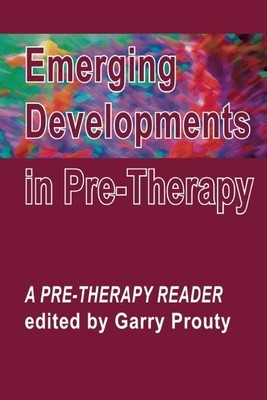
- We will send in 10–14 business days.
- Publisher: PCCS Books
- Year: 2015
- Pages: 194
- ISBN-10: 1906254095
- ISBN-13: 9781906254094
- Format: 15.6 x 23.4 x 1 cm, softcover
- Language: English
- SAVE -10% with code: EXTRA
Emerging Developments in Pre-Therapy (e-book) (used book) | bookbook.eu
Reviews
Description
Garry Prouty writes: In developing this book with my colleagues, I have come to realize that Pre-Therapy is not only a theory and technique of psychotherapy, but also a method of understanding psychological phenomena. Western humanistic psychology has traditionally focused on higher levels of human functioning such as peak experiences or self actualization. In contrast, Pre-Therapy focuses on lower levels of functioning - learning disability, regression, chronic schizophrenia and dementia. Pre-Therapy is a commitment to understand and treat the regressed levels of 'Being in the World'. It is possibly a paradigm shift within western humanistic psychology.In a different sense, Pre-Therapy is a cultural conserve. It maintains a consistent 'non-directive' position derived from mid-20th Century Rogerian Psychology. It also embraces a 'concrete phenomenology'. In Martin Buber's language this is described as 'pointing at the concrete'. Pre-Therapy enables the therapist to contact the patient's regressed levels through the concreteness of the Contact Reflections. What is important about this text, is not Pre-Therapy itself. This can be read in other books and papers.What is important in this text is the growth resulting from Pre-Therapy. Roughly speaking Pre-Therapy has undergone three changes: 1966-1986 'birth' in the United States; 1986-2006 Expansion and growth in Europe; and, The expansion beyond itself to other distinct and separate psychological phenomena - a second generation of theorizing and applications. For the reader not familiar with Pre-Therapy, Part I outlines a brief history of the approach and Part II is a review of the theory itself. Part III contains independent approaches to divergent issues and problems. They have their commonality only by being rooted in Pre-Therapy. They are emergent developments.
EXTRA 10 % discount with code: EXTRA
The promotion ends in 20d.19:49:44
The discount code is valid when purchasing from 10 €. Discounts do not stack.
- Publisher: PCCS Books
- Year: 2015
- Pages: 194
- ISBN-10: 1906254095
- ISBN-13: 9781906254094
- Format: 15.6 x 23.4 x 1 cm, softcover
- Language: English English
Garry Prouty writes: In developing this book with my colleagues, I have come to realize that Pre-Therapy is not only a theory and technique of psychotherapy, but also a method of understanding psychological phenomena. Western humanistic psychology has traditionally focused on higher levels of human functioning such as peak experiences or self actualization. In contrast, Pre-Therapy focuses on lower levels of functioning - learning disability, regression, chronic schizophrenia and dementia. Pre-Therapy is a commitment to understand and treat the regressed levels of 'Being in the World'. It is possibly a paradigm shift within western humanistic psychology.In a different sense, Pre-Therapy is a cultural conserve. It maintains a consistent 'non-directive' position derived from mid-20th Century Rogerian Psychology. It also embraces a 'concrete phenomenology'. In Martin Buber's language this is described as 'pointing at the concrete'. Pre-Therapy enables the therapist to contact the patient's regressed levels through the concreteness of the Contact Reflections. What is important about this text, is not Pre-Therapy itself. This can be read in other books and papers.What is important in this text is the growth resulting from Pre-Therapy. Roughly speaking Pre-Therapy has undergone three changes: 1966-1986 'birth' in the United States; 1986-2006 Expansion and growth in Europe; and, The expansion beyond itself to other distinct and separate psychological phenomena - a second generation of theorizing and applications. For the reader not familiar with Pre-Therapy, Part I outlines a brief history of the approach and Part II is a review of the theory itself. Part III contains independent approaches to divergent issues and problems. They have their commonality only by being rooted in Pre-Therapy. They are emergent developments.


Reviews